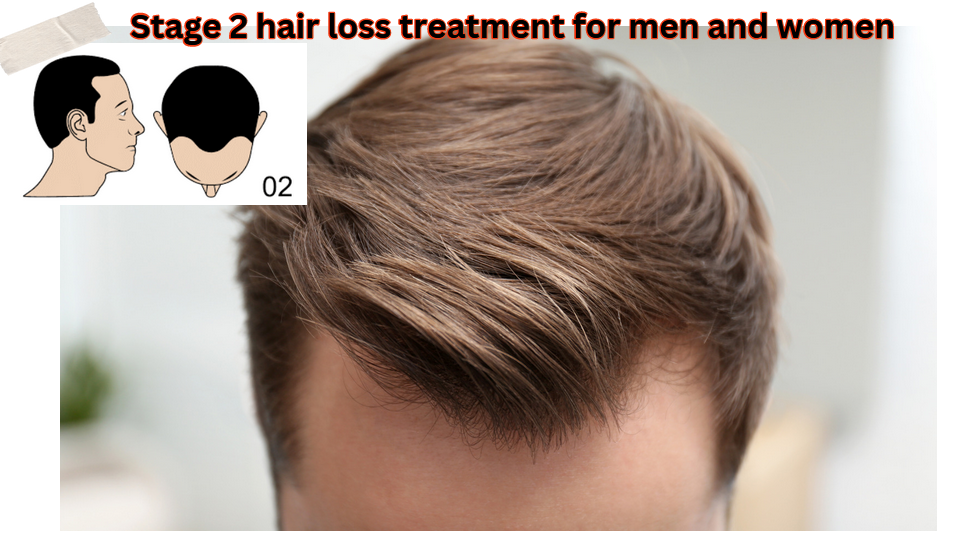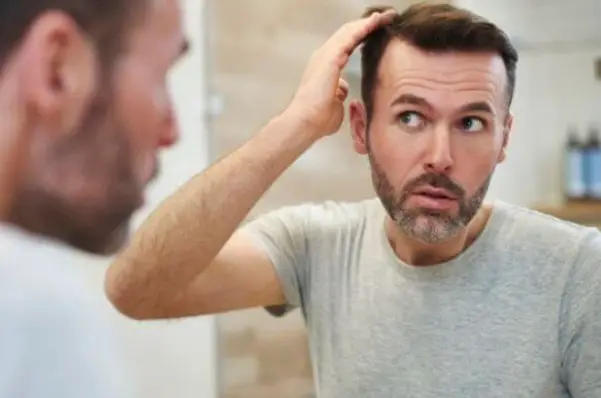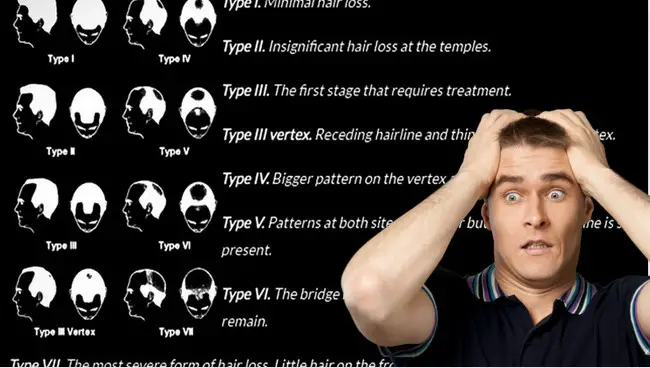Explore our comprehensive guide on Stage 2 hair loss treatment. Understand the science behind hair loss, discover effective treatments like Finasteride and Minoxidil, and learn practical strategies to manage and potentially reverse this condition.
Hair loss is a common concern for many individuals, affecting both men and women. It’s a condition that can significantly impact self-esteem and confidence. However, understanding the stages of hair loss and the available treatment options can help manage this condition effectively. In this article, we’ll focus on Stage 2 hair loss, a stage that is often overlooked but crucial in the hair loss journey.
Stage 2 hair loss is defined as slight hair loss near the skin between the ears and forehead, particularly on the temporal gulfs. This stage corresponds to a mature hairline, with the vast majority of adult men having their hair at this level, with a 1 to 2 cm recession of the hairline. Very slight hair loss can also sometimes be seen at the vertex, the top of the skull. At this stage, no doctor advises undertaking a hair transplant.
However, when the hairline recedes substantially, clearing the frontal temporal gulfs, and the scalp in this area becomes bare, stage 3A of the Norwood-Hamilton scale is reached. This progression underscores the importance of early intervention and treatment during Stage 2 hair loss.
One recommended treatment is the use of Regrowth Foliprime Hair Serum on the scalp. This serum is designed to stimulate hair growth and strengthen existing hair. It’s a non-invasive treatment that can be easily incorporated into your daily routine.
In addition to the serum, it’s advisable to use Kiierr DHT Blocking Shampoo for Hair Growth. This shampoo is specifically formulated to block DHT, a hormone that is a major contributor to hair loss. Unlike many other shampoos that contain harsh chemicals, Kiierr DHT Blocking Shampoo uses natural ingredients that nourish the hair and scalp, promoting healthier hair growth.
If you’re noticing signs of hair loss and have a receding hairline, it’s also recommended to consider lifestyle changes and natural remedies. These can include herbs that stimulate hair growth, Biotin Gummies, or any one of the It Really Works Vitamins Best Supplements for Hair Growth or Best DHT Blocker Vitamins.
Remember, early intervention is key in managing hair loss. If you’re at Stage 2, it’s not too late to take action. By using the right treatments and making necessary lifestyle changes, you can slow down hair loss and maintain a healthy, full head of hair.
Stay tuned as we delve deeper into the stages of hair loss, the dangers of denial, and the importance of taking action to prevent future hair loss.
Related Article:
Key Takeaways:
- Stage 2 hair loss is characterized by a slight recession of the hairline, particularly on the temporal gulfs. It’s a natural stage of hair loss that many men experience as they age.
- Ignoring the signs of Stage 2 hair loss and failing to take action can lead to progression to more severe stages of hair loss, which are harder to treat.
- Treatment options for Stage 2 hair loss include topical treatments like Regrowth Foliprime Hair Serum and Kiierr DHT Blocking Shampoo, lifestyle changes, and natural remedies.
- Lifestyle changes that can help manage Stage 2 hair loss include a healthy diet, regular exercise, stress management, and the use of natural remedies like herbs and hair growth supplements.
- Denial can be a natural response to hair loss, but it can lead to more severe hair loss and the need for more complex and costly treatments. It’s important to acknowledge the reality of hair loss and take proactive steps to manage it.
- Early intervention is key in managing hair loss. By recognizing the signs of hair loss and taking action, you can slow down hair loss and maintain a healthy, full head of hair.
Understanding Stage 2 Hair Loss
When it comes to hair loss, understanding the stages and knowing what to expect can be a powerful tool. The Norwood-Hamilton scale, a widely used measure for male pattern baldness, defines Stage 2 hair loss as a slight recession of the hairline, particularly around the temporal gulfs – the areas on either side of the forehead.
This stage is often referred to as a mature hairline, and it’s a natural part of aging for many men. The hairline may recede by 1 to 2 cm, and there may be very slight thinning at the vertex, or the top of the skull. It’s important to note that this is not a cause for alarm. In fact, the vast majority of adult men experience this level of hair loss.
However, it’s also a crucial stage to monitor. If the hairline continues to recede, clearing the frontal temporal gulfs and leaving the scalp in this area bare, it indicates a progression to stage 3A of the Norwood-Hamilton scale. This is why understanding and recognizing Stage 2 hair loss is so important – it’s a stage where early intervention can make a significant difference in managing hair loss progression.
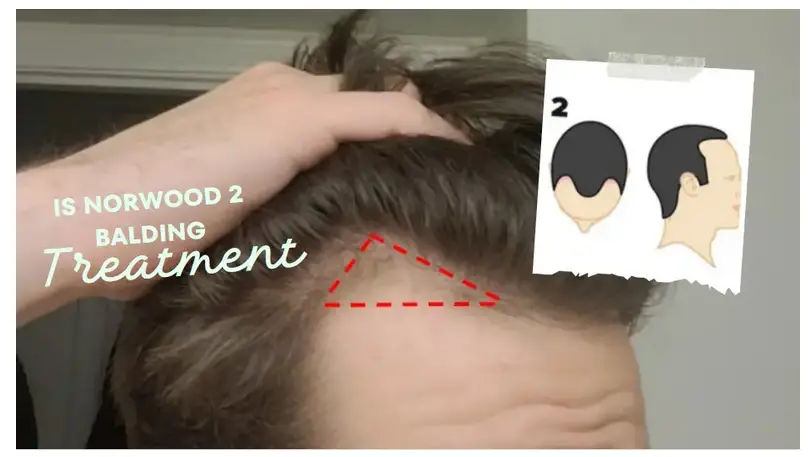
At this stage, it’s not recommended to undertake a hair transplant. Instead, the focus should be on maintaining the health of the existing hair and slowing down further hair loss. This can be achieved through a combination of treatments, lifestyle changes, and natural remedies.
For instance, the use of Regrowth Foliprime Hair Serum can help stimulate hair growth and strengthen existing hair. This serum is applied directly to the scalp, making it an easy addition to your daily routine.
In addition to the serum, using a DHT blocking shampoo like Kiierr DHT Blocking Shampoo for Hair Growth can be beneficial. DHT, or Dihydrotestosterone, is a hormone that can contribute to hair loss. By blocking DHT, this shampoo helps to prevent further hair loss and promotes healthier hair growth.
If you’re noticing signs of hair loss and have a receding hairline, it’s also recommended to consider lifestyle changes and natural remedies. These can include herbs that stimulate hair growth, Biotin Gummies, or any one of the It Really Works Vitamins Best Supplements for Hair Growth or Best DHT Blocker Vitamins.
Understanding Stage 2 hair loss is the first step in taking control of your hair health. By recognizing the signs and taking early action, you can effectively manage hair loss and maintain a healthy, full head of hair.
Related Article: Is Norwood 2 Balding?
The Science Behind Hair Loss
Hair loss, also known as alopecia, is a condition that affects both men and women. It can occur due to various factors, including genetics, hormonal changes, medical conditions, or simply aging. Understanding the science behind hair loss is the first step towards finding an effective treatment.
At the root (pun intended) of hair loss is the life cycle of a hair follicle. Each hair on our head goes through a growth cycle that includes a growth phase (anagen), a transitional phase (catagen), and a resting phase (telogen). After the resting phase, the hair falls out, and a new one grows in its place. However, certain factors can disrupt this cycle, leading to hair thinning or baldness.
One such factor is Dihydrotestosterone (DHT), a derivative of the male hormone testosterone. DHT can bind to receptors in the hair follicles, causing them to shrink and eventually stop producing hair. This process is the primary cause of male pattern baldness, also known as androgenetic alopecia.
For a more detailed look at the science behind hair loss, check out our article on male pattern baldness stages.
Stages of Hair Loss: Focus on Stage 2
Hair loss occurs in stages. The Norwood Scale is a widely used tool for classifying the stages of male pattern baldness. It ranges from Stage 1 (no significant hair loss) to Stage 7 (advanced hair loss).
Stage 2 on the Norwood Scale is characterized by a slight recession of the hairline around the temples. This stage is often referred to as an adult or mature hairline. While it’s not severe, it can be a precursor to more advanced stages of hair loss if not addressed promptly.
For more information on the stages of hair loss, visit our guide on the Hamilton Norwood Classification Scale.
Hair Loss in Women: Is it Different?
While hair loss is often associated with men, it’s important to note that women can also experience this condition. Female pattern hair loss, also known as androgenetic alopecia in women, typically presents as hair thinning on the top and crown of the scalp. Unlike men, women rarely experience complete baldness.
The stages of hair loss in women are classified using the Ludwig Scale, ranging from Stage 1 (mild thinning) to Stage 3 (extensive thinning).
For more insights on hair loss in women, check out our article on female pattern hair loss.
Understanding the science and stages of hair loss is crucial in finding the right treatment. In the next section, we’ll explore common treatments for Stage 2 hair loss.
Treatment Options for Stage 2 Hair Loss
When it comes to treating Stage 2 hair loss, the goal is to slow down the progression of hair loss and maintain the health of the existing hair. There are several treatment options available, ranging from topical treatments to lifestyle changes and natural remedies.
Topical Treatments
One of the most recommended treatments for Stage 2 hair loss is the use of Regrowth Foliprime Hair Serum. This serum is designed to stimulate hair growth and strengthen existing hair. It’s a non-invasive treatment that can be easily incorporated into your daily routine.

To use the serum, simply apply it directly to the scalp, focusing on the areas where hair loss is most noticeable. Regular use of the serum can help slow down hair loss and promote healthier hair growth.
In addition to the serum, it’s advisable to use Kiierr DHT Blocking Shampoo for Hair Growth. This shampoo is specifically formulated to block DHT, a hormone that is a major contributor to hair loss. Unlike many other shampoos that contain harsh chemicals, Kiierr DHT Blocking Shampoo uses natural ingredients that nourish the hair and scalp, promoting healthier hair growth.
Medications
Medications such as finasteride and minoxidil are also commonly recommended for Stage 2 hair loss. Finasteride works by reducing DHT levels in the body, while minoxidil stimulates hair growth. Both medications are available in topical forms and can be used in conjunction with the Regrowth Foliprime Hair Serum and Kiierr DHT Blocking Shampoo for optimal results.
Finasteride
Finasteride, also known by the brand name Propecia, is an oral medication that works by reducing the levels of DHT in the body. By doing so, it can slow down hair loss and even stimulate new hair growth in some cases. However, it’s important to note that Finasteride is typically more effective in the early stages of hair loss. You can learn more about Finasteride and its benefits in our Finasteride guide.
Minoxidil
Minoxidil, often known as Rogaine, is a topical solution that you apply directly to the scalp. It works by prolonging the growth phase of the hair follicles, leading to thicker and longer hair. Minoxidil is available over the counter and can be used by both men and women. For more information on Minoxidil, check out our Minoxidil guide.
PRP and Laser Treatments
When the hairline recedes substantially, clearing the frontal temporal gulfs, and the scalp in this area becomes bare, stage 3A of the Norwood-Hamilton scale is reached. At this stage, treatments like PRP (Platelet-Rich Plasma) and laser treatments can be considered. These treatments can slow down baldness and preserve the remaining hair.
PRP therapy involves injecting platelet-rich plasma into the scalp to stimulate hair growth. Laser treatment, on the other hand, uses low-level laser therapy to stimulate hair follicles and promote hair growth. Both treatments are non-invasive and can be effective in managing hair loss.
Lifestyle Changes and Natural Remedies
Lifestyle changes and natural remedies can also play a significant role in managing Stage 2 hair loss. These can include:
- Eating a balanced diet rich in vitamins and minerals that support hair health
- Regular exercise to improve blood circulation, including to the scalp
- Reducing stress through mindfulness practices like yoga and meditation
- Using natural remedies like herbs that stimulate hair growth, Biotin Gummies, or any one of the It Really Works Vitamins Best Supplements for Hair Growth or Best DHT Blocker Vitamins.
By combining these treatment options, you can effectively manage Stage 2 hair loss and maintain a healthy, full head of hair. Remember, the key is early intervention and consistent treatment.
Related Article: Early Stages of Balding Crown
The Dangers of Denial: From Stage 2 to Stage 3 Hair Loss
Hair loss is a reality that many people face, but it’s also a topic that many people find difficult to accept. This denial can be particularly dangerous when it comes to Stage 2 hair loss. While it’s a stage that many men naturally experience as they age, ignoring the signs and failing to take action can lead to progression to Stage 3 hair loss, which is more severe and harder to treat.
The Psychological Aspect of Hair Loss and Denial
Hair loss can be a significant emotional challenge. Our hair is often tied to our identity and self-esteem, and losing it can lead to feelings of insecurity and distress. This emotional impact can lead to denial – a refusal to accept that hair loss is happening.
This denial can manifest in various ways. Some people may convince themselves that their hair is simply going through a temporary shedding phase, while others may downplay the severity of their hair loss. However, denial doesn’t change the reality of the situation. In fact, it can make things worse.
From Stage 2 to Stage 3 Hair Loss
If left untreated, Stage 2 hair loss can progress to Stage 3. This stage is characterized by a further recession of the hairline and more noticeable thinning at the vertex. The hairline recedes substantially, clearing the frontal temporal gulfs, and the scalp in this area becomes bare.
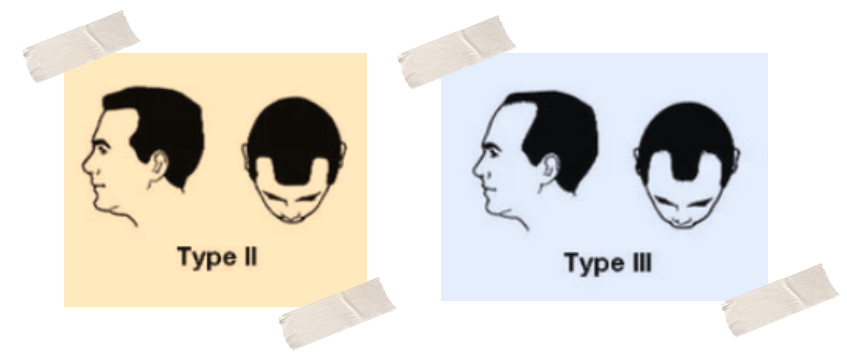
At this stage, treatments like PRP (Platelet-Rich Plasma) and laser treatments may be considered. However, these treatments are more invasive and costly than the treatments typically used for Stage 2 hair loss.
The Importance of Taking Action
The progression from Stage 2 to Stage 3 hair loss underscores the importance of early intervention and treatment. By recognizing the signs of Stage 2 hair loss and taking action, you can slow down hair loss and maintain a healthy, full head of hair.
This can involve using treatments like Regrowth Foliprime Hair Serum and Kiierr DHT Blocking Shampoo, making lifestyle changes, and exploring natural remedies. It’s also important to consult with a healthcare professional or a hair loss specialist to discuss your options and develop a treatment plan that’s tailored to your needs.
Denial can be a natural response to hair loss, but it’s a response that can lead to more severe hair loss and the need for more complex and costly treatments. By acknowledging the reality of hair loss and taking proactive steps to manage it, you can maintain your hair health and confidence.
Remember, hair loss is a common condition that many people face. You’re not alone, and there are treatments and resources available to help you. Don’t let denial stand in the way of taking action and maintaining your hair health.
Related Article: Male Pattern Baldness Stages
Lifestyle Changes and Natural Remedies for Stage 2 Hair Loss
While medical treatments and topical applications play a crucial role in managing Stage 2 hair loss, lifestyle changes and natural remedies can also make a significant difference. These strategies can help slow down hair loss, stimulate hair growth, and improve the overall health of your hair.
Diet and Nutrition
What you eat can have a significant impact on your hair health. A diet rich in vitamins and minerals that support hair growth can help slow down hair loss and promote healthier hair. These nutrients include:
- Biotin: This B-vitamin is essential for hair health. Biotin deficiency can lead to hair loss, so it’s important to include biotin-rich foods in your diet. These include eggs, almonds, cauliflower, and avocados.
- Vitamin D: Low levels of vitamin D have been linked to hair loss. You can get vitamin D through exposure to sunlight, but it’s also found in foods like fatty fish, cheese, and egg yolks.
- Iron: Iron deficiency is a common cause of hair loss. Iron-rich foods include red meat, spinach, and lentils.
- Protein: Hair is made up of protein, so a protein-rich diet can support hair health. Good sources of protein include chicken, turkey, fish, and dairy products.
Exercise
Regular exercise can also help improve hair health. Exercise increases blood circulation, including to the scalp, which can stimulate hair follicles and promote hair growth. Whether it’s a brisk walk, a run, or a yoga session, find a form of exercise that you enjoy and make it a regular part of your routine.
Stress Management
Stress can contribute to hair loss, so managing stress is an important part of managing hair loss. This can involve mindfulness practices like meditation and yoga, as well as other stress-reducing activities like reading, listening to music, or spending time in nature.
Natural Remedies
There are also several natural remedies that can help slow down hair loss and stimulate hair growth. These include:
- Herbs: Certain herbs, like rosemary and ginseng, have been shown to stimulate hair growth. You can use these herbs in the form of essential oils, applying them directly to the scalp.
- Biotin Gummies: These supplements provide a concentrated dose of biotin, which can support hair health.
- Hair Growth Supplements: There are several supplements on the market that are designed to support hair growth. For example, the It Really Works Vitamins Best Supplements for Hair Growth and Best DHT Blocker Vitamins are packed with vitamins and minerals that support hair health.
By incorporating these lifestyle changes and natural remedies into your routine, you can take a proactive approach to managing Stage 2 hair loss. Remember, the key is consistency. It may take time to see results, but with patience and persistence, you can improve your hair health and slow down hair loss.
Related Article: How to Tell If You’re Balding?
Frequently Asked Questions
Navigating the world of hair loss can be confusing and overwhelming. Here are some frequently asked questions about Stage 2 hair loss and its treatment.
What is Stage 2 hair loss?
Stage 2 hair loss is defined as slight hair loss near the skin between the ears and forehead, particularly on the temporal gulfs. This stage corresponds to a mature hairline, with the vast majority of adult men having their hair at this level.
Can hair loss stop at Norwood 2?
Yes, hair loss can stop at Norwood 2, but it’s not guaranteed. Hair loss is a progressive condition, and without intervention, it can continue to progress. That’s why it’s important to take action at the first signs of hair loss.
How do I take care of my hair at Stage 2?
Taking care of your hair at Stage 2 involves a combination of treatments like Regrowth Foliprime Hair Serum and Kiierr DHT Blocking Shampoo, lifestyle changes, and natural remedies. It’s also important to consult with a healthcare professional or a hair loss specialist to discuss your options and develop a treatment plan.
Can hair regrow after 2 years of hair loss?
Hair regrowth after 2 years of hair loss is possible, but it depends on the cause of the hair loss and the treatments used. In some cases, hair loss may be permanent.
What are the treatment options for Stage 2 hair loss?
Treatment options for Stage 2 hair loss include topical treatments like Regrowth Foliprime Hair Serum and Kiierr DHT Blocking Shampoo, medications like finasteride and minoxidil, and lifestyle changes and natural remedies like a healthy diet, regular exercise, stress management, and hair growth supplements.
For more information on hair loss and its treatment, check out our comprehensive on crown stages of balding.
Conclusion
Stage 2 hair loss is a common occurrence, but it doesn’t have to be a cause for alarm. With the right knowledge and proactive measures, you can manage this stage of hair loss effectively. From using targeted treatments like Regrowth Foliprime Hair Serum and Kiierr DHT Blocking Shampoo to making lifestyle changes and exploring natural remedies, there are numerous ways to slow down hair loss and maintain healthy hair. Remember, early intervention is key.
Don’t let denial lead to more severe stages of hair loss. Take action today and give your hair the care it deserves. For more information on hair loss stages and treatments, visit our comprehensive guide on 7 Receding Hairline Stages.
- AI Powered Bald Filter Online 2024: See Yourself with No Hair! - January 19, 2024
- Harklinikken Bad Reviews 2024: Analyzing Negative Feedbacks - January 18, 2024
- How to Get the Alex Eubank Hair | Step-By-Step Tutorial 2024 - January 18, 2024

